Lisbon will host the one-legged affair between RB Leipzig and Paris Saint-Germain in the UEFA Champions League on Tuesday 18th August. This tactical analysis will take a look at how the two teams will face up against each other.
RB Leipzig, led by Julian Nagelsmann, finished the Bundesliga season in 3rd place, utilising several young bright talents in the process. Heading into the winter break Leipzig were at the top of the table, five points ahead of then-third placed Bayern Munich. While Bayern would continue to improve dramatically under Hansi Flick, Leipzig would begin to falter under Nagelsmann, who would collect disappointing draws regularly. Despite only losing four games in the whole Bundesliga campaign, they accumulated twelve draws as well. In this analysis, we will discover how Nagelsmann’s tactics had an influence on this, how he went around dismantling Atlético Madrid, and their tactics, in general, this season.
Paris Saint-Germain, managed by Thomas Tuchel, deserved their quarter-final victory against Atalanta, even though they left their winning goal to injury time. In that game, they had an Expected Goal (xG) value of 2.8 compared to Atalanta’s 0.5 xG, indicative of their supremacy through the entire 90 minutes. Kylian Mbappé came off the bench in that match to make a significant impact and aid his side to victory. Although, much attention was paid to Neymar’s performance, in which he completed a UCL record, sixteen dribbles in one game, and overall produced a sensational display. This analysis will take a deeper dive into how they pulled apart Atalanta’s defence, how they kept out Atalanta’s star attackers, and how having the ability to start Mbappé is a huge benefit.
Predicted Lineups
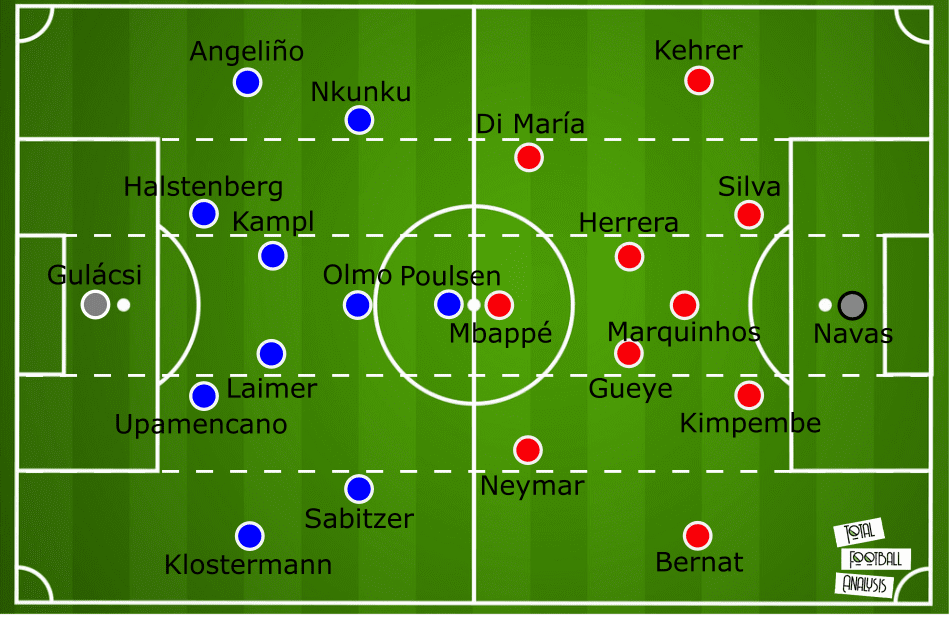
RB Leipzig (4-2-3-1): Péter Gulácsi: Lukas Klostermann, Dayot Upamecano, Marcel Halstenberg, Angeliño: Konrad Laimer, Kevin Kampl: Marcel Sabitzer, Dani Olmo, Christopher Nkunku: Yussuf Poulsen.
For much of the 2019/20 campaign, Leipzig have lined up in a 4-2-2-2 formation, with either Yussuf Poulsen or Patrik Schick partnered with Timo Werner for a striking duo. Of course, losing Werner is a huge loss for Nagelsmann’s side, as he produced the majority of their goal output, while also being a significant creative presence in the final third too. As a result, one would imagine that Leipzig would roll out in the same formation they played against Atlético Madrid, a 4-2-3-1, which used Poulsen as the lone striker, supplemented by two wide men and an attacking midfielder. Although like in their 4-2-2-2 formation, these wide players often operate in the half-spaces, rather than focus their plays down the flanks and look to stretch the opposition defence, they prefer to overload the central areas. Despite Tyler Adams coming off the bench to score the winning goal against Atleti, it can be found unlikely to expect that Nagelsmann would trust the young American to start this game, given his game time this season. The back four could change from this prediction, depending on whether Nagelsmann starts Nordi Mukiele, which would move Klostermann to centre-back, Halstenberg to left-back, and Angeliño to the bench.
PSG (4-3-3): Keylor Navas: Thilo Kehrer, Thiago Silva, Presnel Kimpembe, Juan Bernat: Ander Herrera, Marquinhos, Idrissa Gueye: Ángel Di María, Kylian Mbappé, Neymar.
In their last game against Atalanta, PSG were without Di María and Mbappé, with Sarabia and Icardi coming in to replace both of them respectively. This can be seen as a considerable talent drop-off, but Tuchel’s side did not suffer too much as a result. Altogether, this was largely thanks to Neymar, as he truly carried that frontline to create chances of any great value, as he took on the opposition defence directly, forcing them into defensive errors regularly. Marco Verratti is back in training, but the game should come too soon for him to start in, or even make a substitute appearance. This is still a substantial loss for Tuchel’s side, as he has been so key to his side this season, particularly in the transition with his solid ball retention and elite ball progression. Di María coming back into the fore is a massive plus, as he has been truly sensational in the UCL this season, able to act as a dual-threat in the final-third to great effect.
Leipzig’s rotations and verticality in the attacking phase
Red Bull, as an association, have a playing methodology which is consistent throughout all their clubs across the world (Leipzig, Salzburg, New York, etc.). They attack vertically through quick forward passes, press aggressively out of possession, and interestingly, this season under Naglesmann, Leipzig have displayed more tactical versatility, with the coach switching between three at-the-back and four at-the-back systems, depending on the strength of the opposition. Within these systems, the tactical concepts stay the same, with the main differences coming from how the build-up their attack from the back in the attacking phase, whether they are in a four at-the-back or three-at-the-back system. The main differences are unavoidable, given that the positional slots in the systems are different. The concepts that underpin these systems will, however, remain the same.
One of these concepts is one of rotation in the build-up. The full-backs or wing-backs will position themselves relatively high up the pitch in the beginnings of the build-up phase. This is a simple tactical mechanism to provide width, but also to force the opposition to defend in a wider block to cover this threat. This, in turn, creates space centrally that Leipzig can exploit to progress the ball forwards (see beneath). Leipzig’s central defenders will split wide, either in a chain of two or three, depending on the system selected, then the deepest central midfielder will drop back to provide a passing option to the man in possession. The use of this central midfielder is used to provide a passing option beyond the first line of pressure from the opposition.
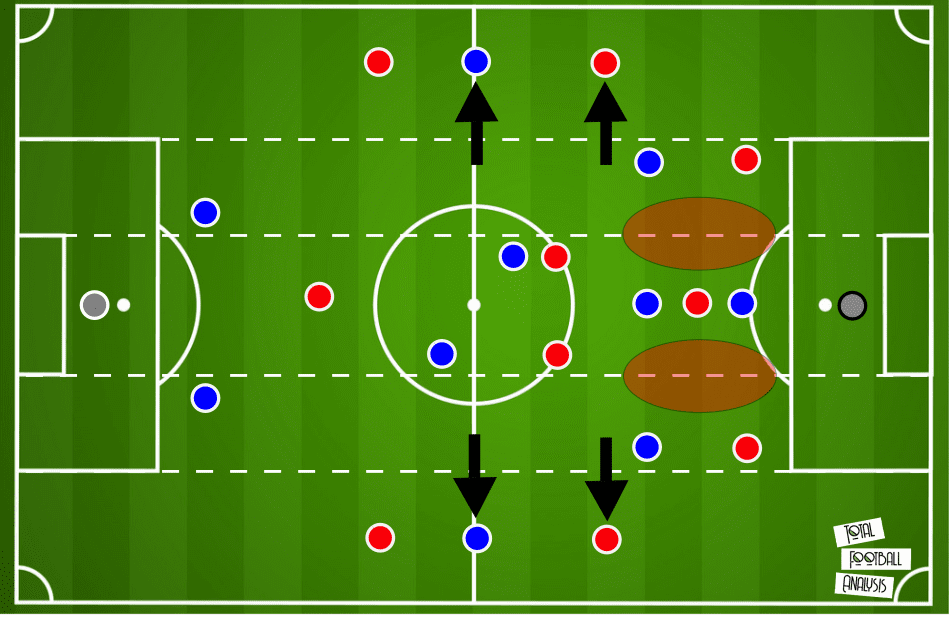
Verticality in possession is key to Nagelsmann’s side in the build-up, meaning he does not want his team to cycle the ball from side to side aimlessly along the defensive line. Instead, for each receiving player, there is one key priority, which is to look to play forward. Obviously, at times there will be no vertical pass open, in which instance, the ball will be moved across, and the next player will look to play the vertical pass from there (see below).
Whether setting out in a back four or a back three, there is still one aspect of the tactical system that is constant, which is the use of a double pivot at the base of the midfield. This is important as these two players provide security when Leipzig are in the attacking phase, but they also screen the defensive unit when the opposition are attacking.
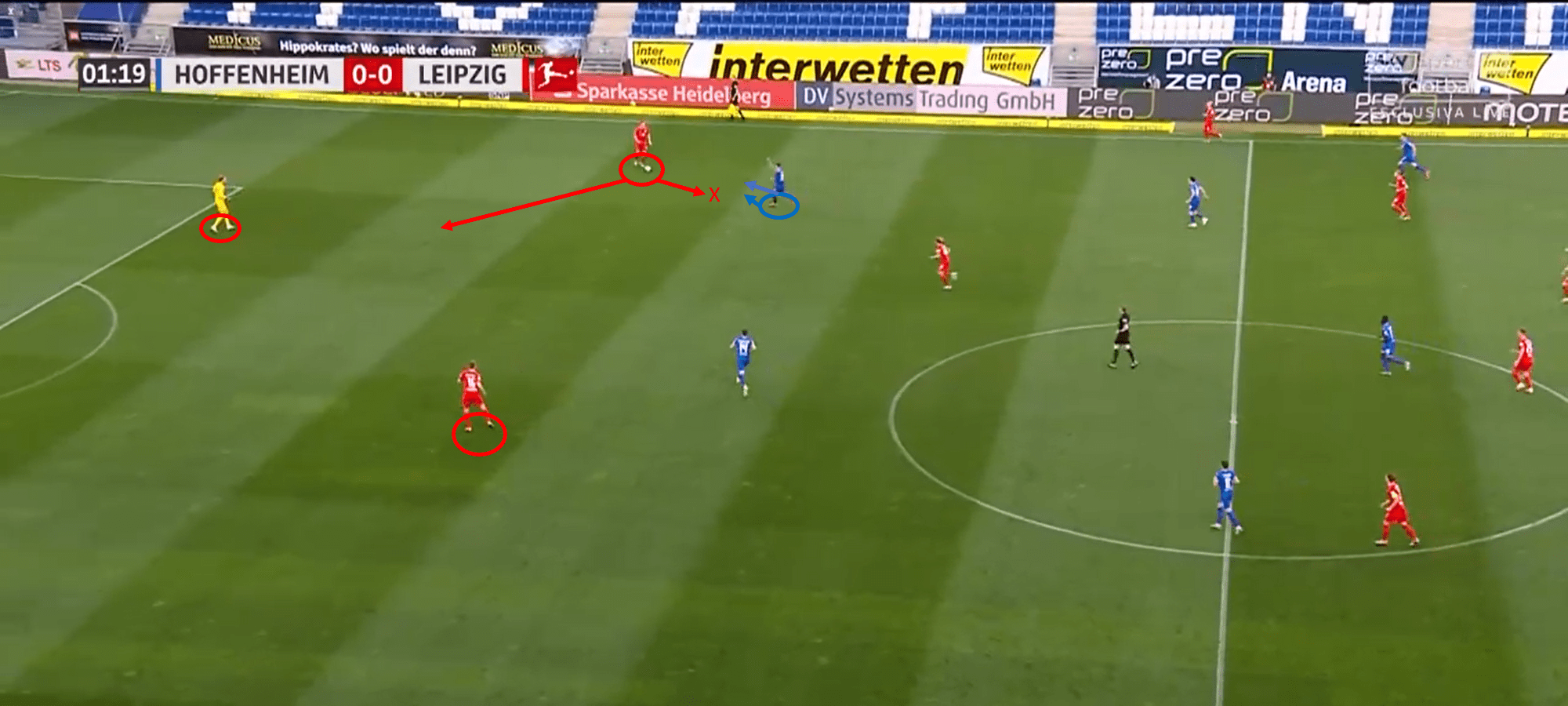
Notice the Leipzig defender on the ball and the opposition applying pressure. This is blocking off his ability to play the vertical pass, so he has the opportunity to rotate back to the goalkeeper who can either play the long ball or pass to the other centre-back, who can then play it vertically.
While at Hoffenheim, Nagelsmann tended to use only one player in the base of the midfield, he has adjusted to using a double pivot at Leipzig to great effect. In using two players in this pivot position, we see the versatility to allow one player to rotate into advanced positions when in possession, while the other retains a deeper position. In possession, it is rare to see these players operating on the same line as one another, instead, they will tend to be staggered, with the player closest to the ball positioned deeper. This allows the ball to be played into the double pivot, and then played forward to the second player in the pivot, which adds to the verticality in possession.
In the attacking phase, we regularly see attacking players take up spaces between the lines of the opposition and allowing the vertical pass to be played into dangerous zones. In the final third, in particular, we will see Leipzig overload the central areas before playing quick vertical passes that bypass the opposition defensive block. This is the main reason why Leipzig create so many opportunities on goal in their games this season, they have perfected the art of playing these vertical combinations. As the ball is played centrally into the feet of an attacking player, as soon as the pass is played, the second striker starts moving and the ball is immediately played through the last line to create a goalscoring chance. In moving so many players high up the pitch, Leipzig makes it very difficult for the opposition’s defensive block.
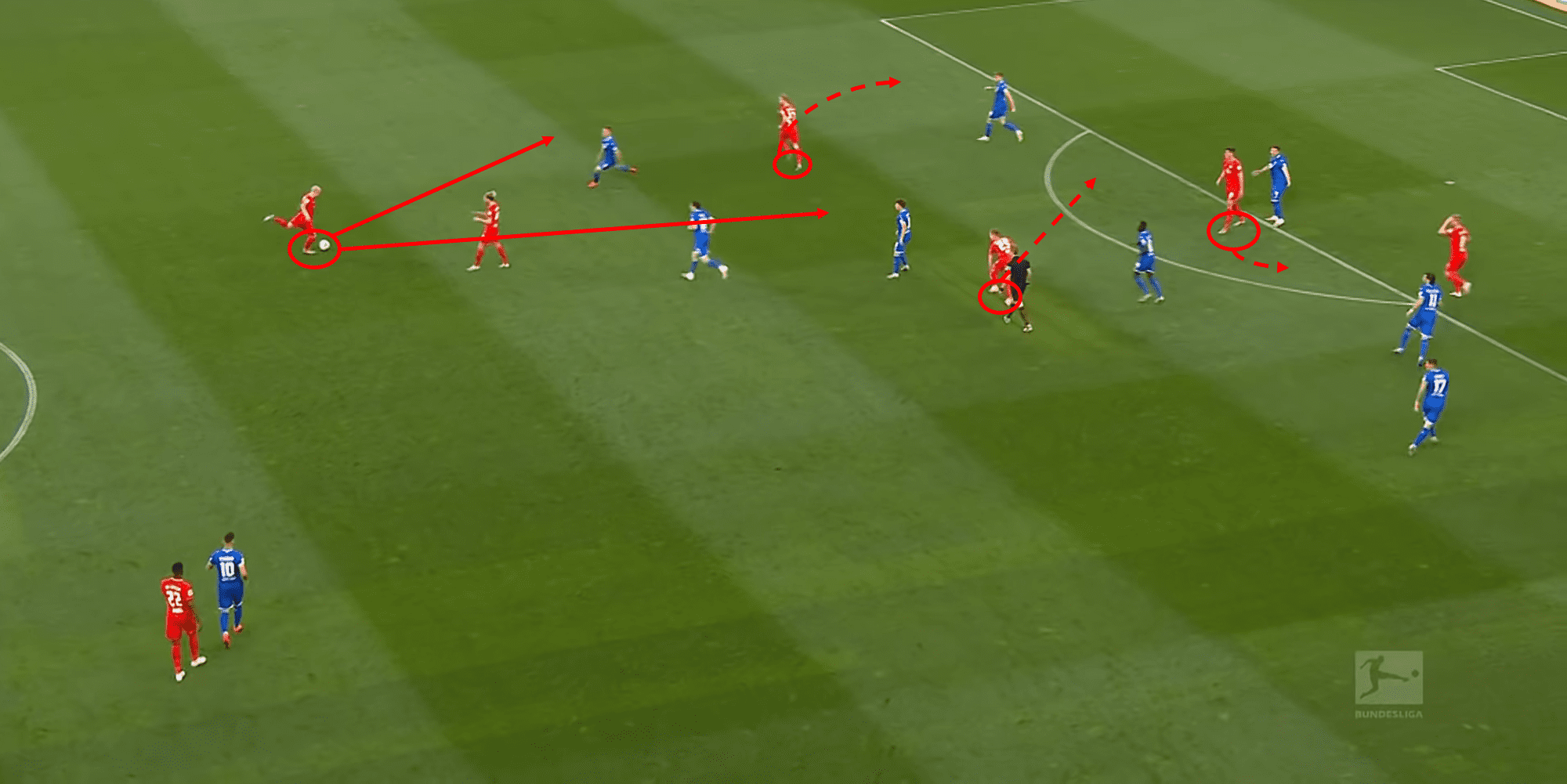
Here, we can see Kampl on the ball with a variety of options for a vertical pass. He could pass down the half-space, which would release Forsberg to link-up with Olmo who would burst into the central zone of the penalty area. Finally, leaving Schick to lose his man and find space in the box for the finish.
When a player has no pressure on the ball in the midfield, a pass can be made to a player who is between the lines of the opposition defence and midfield. This receiving player has then created an advanced platform from which Leipzig can threaten the opposition defensive line. These advanced platforms are important as the ball progresses forward since they allow supporting players to move into advanced areas and affect the positioning of the defensive block. This then creates gaps across the width of the field that can be exploited through quick combinations.
Key players: Upamencano vs Mbappé
Upamencano now sits as possibly the highest-rated young centre-back on the planet after his performance against Atletico, with links to Real Madrid and Manchester United. The young Frenchman’s performance against Atletico was a sight to behold. Upamencano won 100% of his defensive duels, completed 92% of his passes, and had 99 touches of the ball, the latter of which being a match-high amongst anyone on the pitch.
If a player does manage to take the ball past Upamencano, they will soon discover the Frenchman’s electric pace and likely lose the footrace. This is something Mbappé must be aware of before approaching the game if he is to add to his 33 goals in all competitions this season.
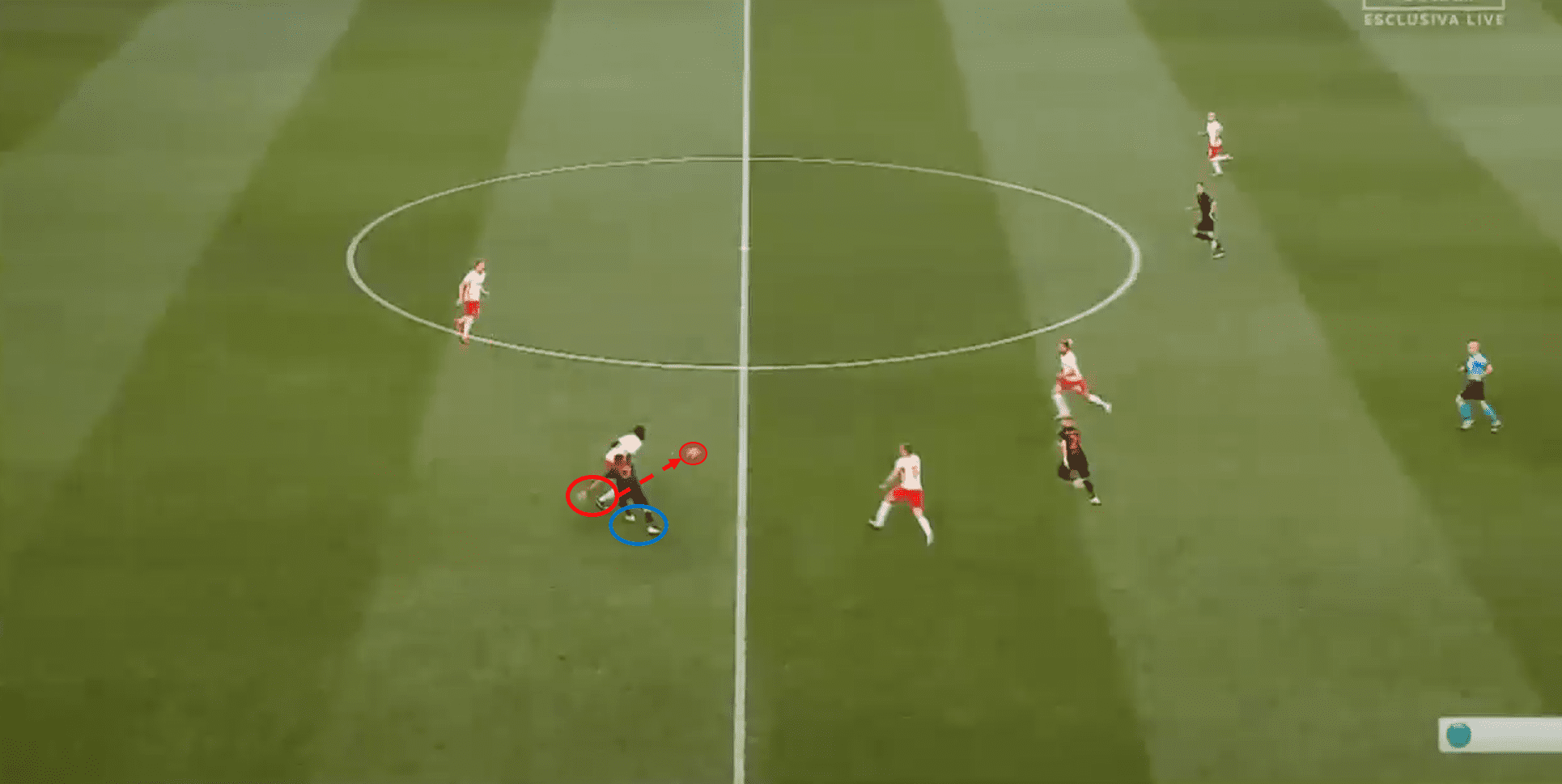
After winning the aerial duel against Diego Costa, Upamencano receives the ball and carries it up the pitch with the ball at his feet, emblematic of his style of play generally.
PSG’s transformation into a 4-2-2-2 or 4-3-3
In a 4-3-3 formation, PSG’s forwards drop off regularly, entering the wide zones or the half-space, while the full-backs tend to overlap. The aim of this being to overload the midfield while simultaneously disrupting attempts to mark the forwards and create space to run into. Their midfield set-up is staggered with one defensive midfielder typically staying back to provide defensive cover, while another midfielder will also drop back to act as a second deep distributor of the ball. The third midfielder pushes up higher, to provide an attacking option to outnumber the opposition on one side of the pitch. Additionally, this overloading of one side of the pitch is exploited by quick switches to the other flank, which is in sync with their pressing, which will press one side of the pitch, and then once they have regained the ball, look to immediately switch play to the other side of the pitch.
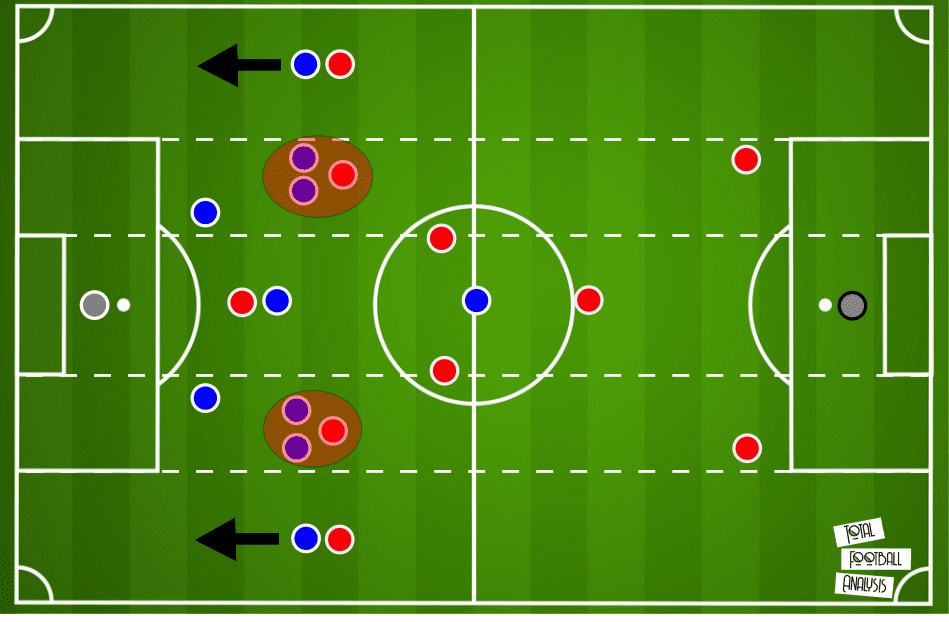
Although this is their typical tactical approach while utilising the 4-3-3, Tuchel is flexible and adaptive with his set-ups, often altering formations and line-ups to counteract the key threats of an opposition. This is something he has been forced to do throughout his time at PSG, with injuries to key players such as Neymar, Verratti, or Rabiot once upon a time. For example, they have used the previously mentioned 4-4-2 formation to a great degree of success in these times. Though this is not a case of experimenting with different systems, more-so Tuchel is trying to exploit the weaknesses of his opposition, which has been one of his biggest achievements to date in the French capital.
PSG’s weakness in their defence can sometimes become apparent when a side can press just as well as they do, in these cases succumbing to that pressure and losing possession of the ball. Additionally, when the defence forms into a 3 at the back in-game, the central defenders can be dragged out of position quite easily, and as such quality chances can be created.
Tuchel’s tactical approach vs Atalanta
Atalanta’s defence were easily manipulated by Tuchel’s forwards, with their tendency to follow the PSG forward’s movements allowing space for other forwards to exploit throughout the match. All three of Atalanta’s defenders came close to their man, to do man-marking, and box out PSG’s elite forwards, especially Neymar. Here, they were not playing as a defensive unit, rather than focusing on the movements of the PSG forwards, which would often be exploited by the likes of Neymar or Sarabia. The lack of organisation at the backline was clear to see for Marquinhos’ goal (see an analysis of this below).
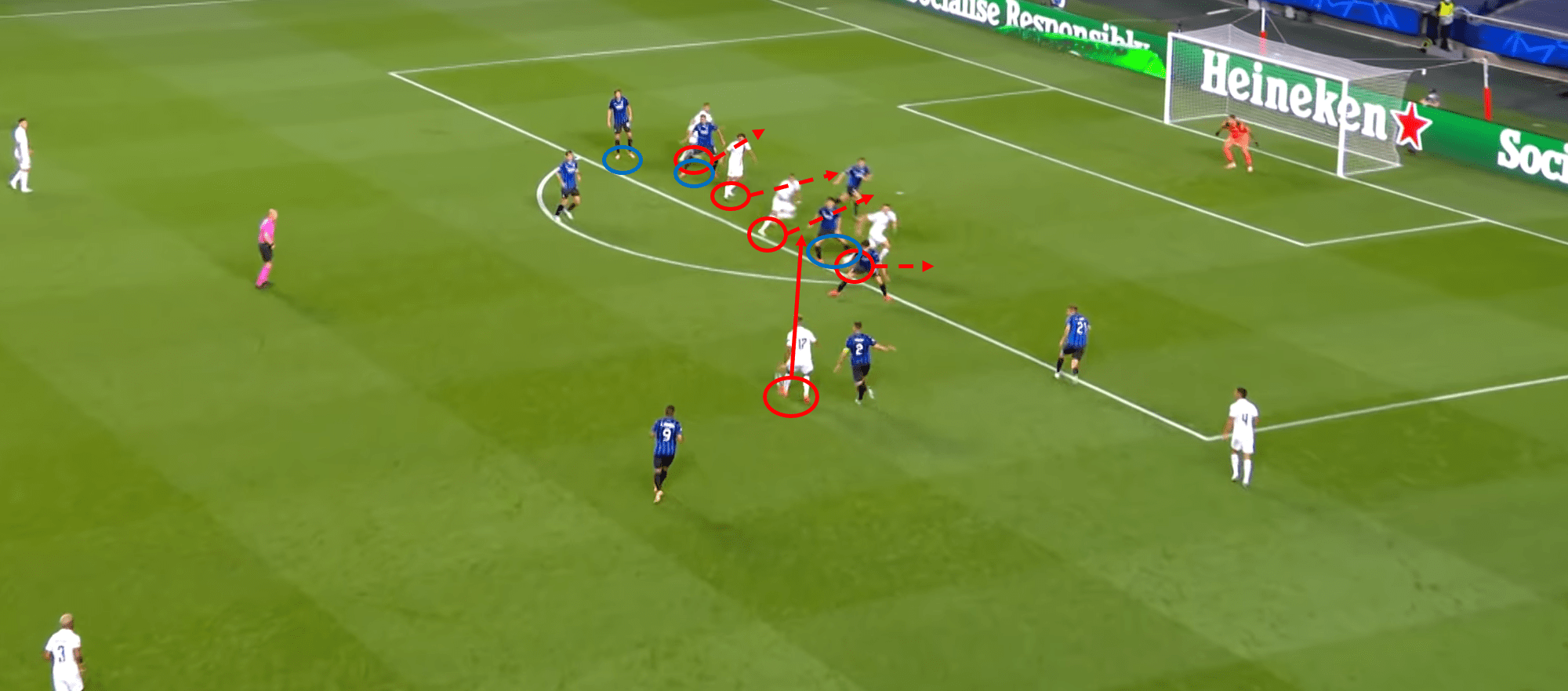
Above, we can see PSG’s players high up the pitch and kept onside by an Atalanta defender, but beyond the rest of the defensive line. This lent heavily in PSG’s favour, who got in behind and made for an easy cutback for Marquinhos’ equaliser.
Les Parisiens would attempt to exploit that in a variety of ways. Navas would strive to send long balls to the forwards, especially Neymar, who found himself positioned between the lines of the midfield and defence and drag Caldara towards him. On occasion, Neymar would also drift wide and take Caldara into these wide areas with him, creating more space centrally, which is where they found the majority of their greatest goal-scoring opportunities. In addition to Navas’ long balls, Tuchel’s defender would also be asked to play vertical passes towards the forwards, just like we saw with our analysis on Leipzig’s verticality in possession. These passes would go directly to a forward (e.g. Neymar), who would then immediately lay-off the ball to one of their midfielders, largely either Herrera or Gueye. Drawing attention to their locations, these midfielders could then find the run of one of their fellow attackers, who could exploit the spaces left open by the proactive Atalanta defenders.
Though, as many would have seen, Neymar essentially ran the PSG attack, with the ball at his feet and creating utter chaos via his dribbling. In addition to his previously mentioned sixteen dribbles, he also suffered nine fouls within the 90 minutes, which is useful to a side who has a set-piece specialist such as Di María. Neymar, on the left flank, would often receive the ball, drift wide to pull his marker with him, and then send the ball in behind the Atalanta defence, who were dragged out of position. With these defenders out of position, Icardi or Sarabia could attack this space with their pace. Once in the final-third, Neymar would look to receive the ball to carry it into dangerous zones, such as near the byline to provide a whipped ground delivery into the box towards either Icardi or Sarabia.
As well as this, Neymar would, of course, cut inside with the ball at his feet and look to shoot directly on goal. When receiving the ball before the final third, he would often drift into the half-space and carry the ball up the pitch. From here, he would force his opposing defender into a misplaced tackle and burst past his man. This often led to him finding space to shoot inside the penalty area, and he finished the game with seven shots. Uncharacteristically, his finishing was poor, as four of his attempts were not even on target, and on a few occasions, these shots went flying wide, nowhere near its intended target. Thankfully, this did not discourage Neymar in his final-third endeavours, as he went on to provide the equalising assist for Marquinhos’ finish.
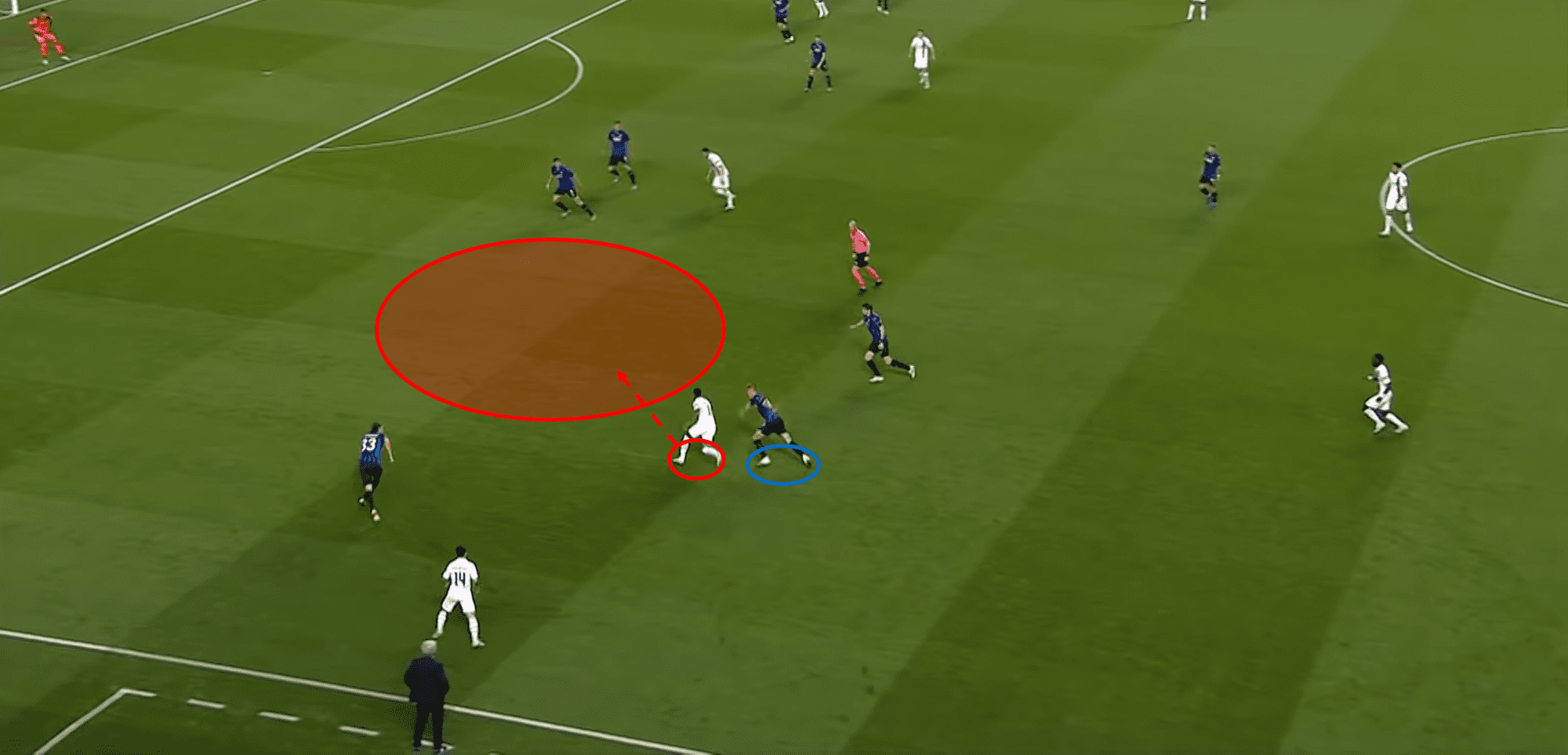
After going past Mario Pašalić, Neymar drifts inside towards the half-space, where there is plenty of space for him to exploit. This proposes an issue for Atalanta, do they come towards him and apply pressure, or block off any passing options.
Final Predictions
What does all of this mean for the upcoming UCL tie? Losing Werner is a huge loss for Leipzig, and this was noticeable in their last match against Atletico, as they lacked his electric pace and striker’s instinct in the final third. Poulsen is a capable forward in his own right, but for very different reasons, as he fits under the role of ‘defensive forward’ and looks to get the best out of his fellow attackers. This can be seen in the Dane’s 6.53 successful pressures per 90 minutes across all competitions this term.
Whether they operate in a 4-2-2-2 or a 4-2-3-1, Leipzig’s tactical concepts remain the same, given for a few small tweaks in the final third. Leipzig can boast a better defence collectively than Atalanta, and this should be taken into consideration from PSG’s standpoint. Atalanta’s three centre-backs were effortlessly dragged out of position, which created space for one of PSG’s forward to enter into dangerous zones with the ball. As a back four, in addition, to have two screening midfielders, PSG will have a more difficult task in getting past Leipzig’s blocks of pressure, especially against the likes of Upamencano or Laimer, who are both fantastic defensive assets to Nagelsmann’s side. In the build-up phase, Leipzig will face three defensive midfielders, who look to aggressively press their opponent’s off the ball, which could be used in Leipzig’s favour if they use their verticality in possession to their advantage and find players like Olmo or Nkunku in favourable attacking zones. Sabitzer is also a reliable presence in the final third, who is brilliant at finding space in between the lines and swiftly moving the ball on towards another forward in the penalty area, or even positioning himself in the penalty area and looking to score a chance himself, making him a legitimate dual-threat.
If Tuchel’s side performs as they did in the last round, they may struggle to break down this Leipzig defence. Although Neymar put in a spectacular overall performance against Atalanta, will he be able to recreate these endeavours so soon after? We can only wait and see. Though Di María is back for this game and will hopefully add some true dynamism to their final-third displays, and more importantly, carry some of the attacking burden off of Neymar’s shoulders. In this case, one would imagine that Tuchel’s men will outnumber Atalanta in the midfield and that this midfield battle, at least on a possession basis, will be won by Les Parsiens. Additionally, Mbappé will also likely be starting this fixture as well, though it should be noted that he will not be fully fit and will be potentially aggravating his ankle injury. Nonetheless, he will be a far more active final-third presence than Icardi, who will look to get more involved in the build-up than the Argentinian as well. Despite these worries, it would be of a huge concern to Leipzig that PSG may just have far too much in the final-third for them to deal with in terms of raw talent.
VAR can change the result of any game, depending on what the refereeing team decide to give on the day. So, this makes it hard to predict an exact result. Nevertheless, my final prediction would be a 3-1 victory for PSG.




Comments